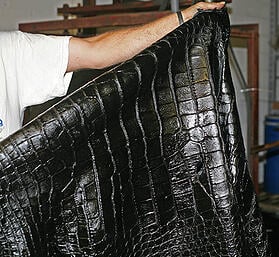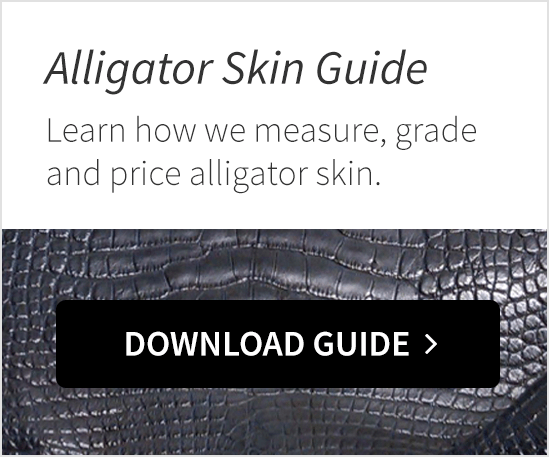How To Tan A Gator Hide
We've received a lot of inquiries lately every bit to what goes into the tanning process for alligator leather. In this post, nosotros'll pause down the basic steps of tanning and so you can get a improve understanding of the procedures that goes into achieving a high-quality tanned alligator skin. Put merely, tanning is the transitioning of a raw peel into bodily leather. Without this crucial process, the skins are susceptible to bacteria and decomposition. From a high level, tanning requires these steps: The Beginning Steps When we receive the skins from the suppliers, they're rigid and extremely susceptible to being affected by the elements. They arrive salted, which is helpful, as this removes the water from the skins and preserves them until they are ready to be processed. The starting time stage of the process is the beaming, when we soak the skin in water to clean the skins, remove the salt and then rehydrate the skin so nosotros tin can begin working them. The Tanning Process Later this, we move onto liming — which removes scales, nails, mucins, natural greases and fats. This also splits the fibers to makes the collagen in the skin more than flexible. Side by side, we delime the pare to raise the acidity after the liming lowers it. The next phase is the pickling which serves as an acid bath to break downwards the bones and calcium in the alligator pare so information technology becomes even more pliable. Afterwards the pickling process comes the chrome bath which makes the skin durable and no longer succeptible to the elements. One time this is washed, the alligator skin is no longer an organic material — information technology has become inorganic leather. Finishing Touches After this, we re-tan the leather, this fourth dimension using vegetable-based products. This is done then that the tougher skin that is created from the initial tanning process is fabricated supple again. Nosotros so either hang-dry out or "toggle" (which uses a special type of oven to evaporate the water) to remove the water and humidity. From at that place, the finishing process begins, where nosotros dye the leather, shave it downward to the required thickness and weight for the application. Then, a top coat is applied with seasons and protective agents so that it feels and looks good — and is resistant confronting external factors like water, light and rubbing. After this, the product goes to the manufacturer where they turn it into the garments, footwear, furniture and handbags that yous're familiar with. This is the basic overview of our tanning procedure and nosotros hope it's both informative and insightful. Should you have any questions, please feel free to comment beneath. And don't hesitate to contact us!


Topics: alligator skin
Source: https://www.panamleathers.com/blog/bid/253262/How-We-Tan-Alligator-Skins

0 Response to "How To Tan A Gator Hide"
Post a Comment